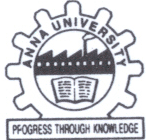Coringa:
The
Godavari divides into two major distributaries at Dawaliswaram. The Godavari joins
the sea at Coringa above 53 km upstream from Vrudha. The tidal channels are deep
and usually U-saped in cross section with steep banks-and tidal creeks originate
from these channels. Such creek criss-cross the mangrove swamps. The mangroves
are the Gautami's gift and they grow on muddy flats formed due to silting activity
spread over many centuries. The estuary meets the sea at Coringa. Geographically
it is located between 16║ 27'-16║ 59' N latitude and 82║ 10'- 82║ 22' E longitudes
and it covers an area of 235 km▓.A complex of mangrove swamps and coastal lagoons
form the Coringa Wildlife sanctuary, in the northeastern part of the Godavari
Delta. Table 4 shows the areas of various wetland classes of Coringa.
Fig: Coringa
Mangroves

Table
4. Various
wetland classes and its areal extent of Coringa
| Sl
No | Wetland
classes | Area
in km▓ |
| 1 |
Mangroves |
171.4 |
| 2 |
Plantation |
10.63 |
| 3 |
Mud flat |
48.4 |
| 4 |
Sandy beach |
20.8 |
| 5 |
Aquaculture
Ponds | 2.8 |
| 6 |
Salt pan |
0.05 |
| 7 |
Sand Dunes |
14.9 |
Fig: Ecologically
Important Area in Andhra Pradesh: Coringa

Biodiversity
Fauna
The
mangrove vegetation in Godavari mangrove ecosystems encompass from giant forests
of Avicennia
officinalis and
Sonneratia
and the other species include Avicennia
marina Excoeras agallocha, rhizopora apiculata, Bruguiera gymnorrhiza, Ceriops
roxburghaina, Aegiceras corniclatum and Lumnitzera racemosa.32 species
of mangrove and mangrove associated plants belonging to 26 genera and 18 families
are recorded in Godavari mangrove ecosystem.
Flora
Zooplankton
Godavari mangrove ecosystem
has 27 groups of zooplanktons.
Macrobenthos
The macrobenthic animal of Krishna
mangrove ecosystems are represented by 15 groups. They are:
Sea
anemones, Nemerteans, Polychaetes, Oligochaetes, Mysids, Isopods, Amphipods, Prawns
Crabs, Halacarid mites, Insect larvae, Univalves, Bivalves, Fish juveniles
& Sipunculids.
The group polychaetes are represented
by 18 species. They are: Phyllodoce
castanea, phyllodoce malmgreni, Namalycastis indica, Dendronereis arborifera,
Nereis indica, Nereis cricognatha, Nereis sp. Ceratomereis burmensis sp. Nephthys
dibranchis, Lumbriconereis simplex, Glycera longipinnis, Laonice cirrata, Magilona
sp. Capitella sp. Sternaspis scutsts, Streblosoma cespitosa and
Laonome
indica.
Meiobenthos
Meiobenthos
are comprised into 12 groups. The harpacticoid copepoda is represented by 22 species
in Krishna delta mangrove habitats. The following are observed: Longipodia
weberi, Canuella perplexa, sunaristes sp. Halectinosoma curticorne, Halectinosoma
gothiceps, Tachidius disciples, Pseudostenhelia secunda, Stenhelia longifurca,
St (D). madrasessis, robertsonia sp. Amphiasdcoides sp. Amiera parvula, Nitocra
spinipes, Phyllopodopsyllus longicaudatus, Stenocopia sp. Enhydrosoma buccholtzi,
Enhydrosoma sp. Cletocamptus confluens, Nannops palustris, Limnocletodes behningi,
Onychocamptus bengalensis, Quinguelaophonte quinquespinosa.
Molluse
are Represented by 23 species belonging to 29 genera and 14 families. They are:
Univalves:
Neria chameleon, Neritina depress; Littorina scabra, L. melanostoma, L.intermediate;
Assiminea brevicula; Cerithidae fluviatilis, C. decollate, Telescopium telescopium,
Terebralia palustris; and Onchidium verruculatum.
Bivalves:
Anadara
granosa; Perna viridis; Plancenta; Meretrix casta, Katelysia opima; Tellina ala
and Solen sp.
Prawns:
18 species of prawns belonging
to 8 genera and 3 families occur here. The genus Metapenaeus was
represented by 5 species by the Genera
Penaeus and Macrobrachium.
Crabs:
11
species of crabs belonging to 10 genera and 3 family are recorded. They include:
Scylla
serrata, Portunus pelagicus, Charybdis cruciata, Uca dussumieri Macropthalmus
crinitus, Pachygrapsus sp. Varuna, litterata, Sesarma oceanica, Sesarma quadrata,
Metopograpsus messor and
Grapsus
strigous.
Finfish:
106
finfish species belonging to 78 genera and 52 famillies were present.
Mullets (mugil cephalus, Liza melanoptera, Valamugil cunnessius),
Croackers (Dendrophysa resselli), Indian shads (Hilsa ilisha) catfish (Arius caelatus),
grunters (Pomadasya hasta), Perches (Lates calcarifer), Pomfrets (Pampus argentitus),
goatfish (Upeneus sulphureus) and eels
(Anguill bicolor).
Birds:
The
following species of birds are seen in Krishna mangrove ecosystem.
Podiceps ruficollis, Pelicanus philippensis, Anhinga rufa,
Palacrocorax niger, Ardea cinerea, Egretta sp. Ardeola greylil, Ibis leucocephalus,
Pseudibis papillosa, Anser indicus and Anas
sp.
Threats:
The Godavari mangrove ecosystem,
like other biotopes,has been experiencing the human-impact in the form of resource
utilization and resource alteration / modification. The utilization of mangrove
resources reached the stage of indiscriminate exploitation (e.g.) excessive deforestation,
injudicious harvesting of juveniles and over-seining of mangrove water for fish
and shellfish seeds for aquaculture practice. Further, the current boom of aquaculture
practice in brackish water habitatsabd expansion of agriculture in the hinterland
have led leading to increased encroachment on the land ward margin of the forests,
and overgrazing by cattle from neighbouring villages is becoming a problem. The
proposed construction of a new road from Nagayalanka town to Nagayalanka lighthouse
would involve the destruction of some of the mangrove forest.

